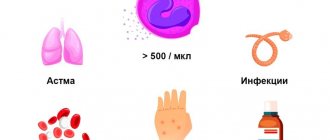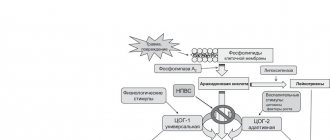Fitness trainer, nutritionist Nika Tyutyunnikova: “To prevent hypomagnesemia, you need to eat cereals, legumes, dried fruits and nuts every day. Excellent options: oatmeal and buckwheat porridge, millet, barley, beans, pine nuts and walnuts, peanuts, dried apricots and prunes. But for good absorption of magnesium (Mg), firstly, vitamin B6 is necessary (therefore, the listed products are best combined with eggs, beef, cod, mackerel). And secondly, potassium (K), which is often found in excess in the same foods as magnesium.”
The biological role of magnesium can be described in dozens of separate articles, and still the topic will remain open. The compound acts as an “helper” (activator) of enzymes, participating in most enzymatic reactions. Without it, protein synthesis is impossible. The substance affects the functioning of the nervous and cardiovascular systems, the neuromuscular system, therefore magnesium preparations are in demand in cardiology and neurology. By ensuring proper intake of the mineral with food and water, you can count on the following results:
- normalization of emotional background;
- improved mood;
- subsidence of symptoms of premenstrual syndrome and menopause;
- improvement of brain activity;
- reduction in the frequency of seizures;
- lowering cholesterol levels;
- increased intestinal motility.
A constant feeling of “overwhelm,” fatigue, and irritability are typical signs of magnesium deficiency.
Grocery list
As Nika Tyutyunnikova says, the lack of mineral intake in the body is easily corrected. To do this, you need to normalize your diet. Be sure to include fresh fruits and vegetables, nuts, meat and fish in your menu. Avoid processed foods and refined carbohydrates (baked goods, alcohol, desserts, candies). Quit smoking and don't overuse caffeine. When composing your menu, give preference to the products from the following table.
Potassium and magnesium are synergists and enhance each other’s absorption.
Table - list of foods rich in magnesium
| Product | Mg content, mg per 100 g |
| Sesame | 540 |
| Wheat bran | 448 |
| Cocoa (powder) | 425 |
| Sunflower seeds (seeds) | 317 |
| Cashew | 270 |
| Buckwheat (grain) | 258 |
| Pine nut | 251 |
| Buckwheat flour | 251 |
| Oat bran | 235 |
| Almond | 234 |
| Soybean (grain) | 226 |
| Buckwheat (kernel) | 200 |
| Peanut | 182 |
| Sunflower halva | 178 |
| Mung beans | 174 |
| Sea kale | 170 |
| Low-fat dry milk | 160 |
| Hazelnut | 160 |
| Buckwheat (prodel) | 150 |
| Barley (grain) | 150 |
| Powdered milk (15%) | 139 |
| Oats (grain) | 135 |
| Bitter chocolate | 133 |
| Red granular caviar | 129 |
| Oat flakes "Hercules" | 129 |
| Chickpeas | 126 |
| Pistachios | 121 |
| Walnut | 120 |
| Rye (grain) | 120 |
| Powdered milk (25%) | 119 |
| Oatmeal | 116 |
| Rice (grain) | 116 |
| Wheat (grain, durum) | 114 |
| Oat flour (oatmeal) | 111 |
| Oat flour | 110 |
| Wheat (grain, soft variety) | 108 |
| Dried apricots | 105 |
| Beans (grain) | 103 |
| Dried porcini mushrooms | 102 |
| Prunes | 102 |
| Chocolate candies | 99 |
| Wheat flour | 94 |
| Squid | 90 |
| Peas (shelled) | 88 |
| Parsley (greens) | 85 |
| Sorrel (greens) | 85 |
| Millet groats (polished) | 83 |
| Dried acorns | 82 |
| Spinach (greens) | 82 |
| Dry cream (42%) | 80 |
| Lentils (grain) | 80 |
| Pasta made from premium flour | 76 |
| Rye wallpaper flour | 75 |
| Wheat flour 2 grades | 73 |
| Dill (greens) | 70 |
| Dates | 69 |
| Milk chocolate | 68 |
| Basil (greens) | 64 |
| Quinoa (boiled in water) | 64 |
| Wheat groats | 60 |
| Peeled rye flour | 60 |
| Sea bass | 60 |
| Figs | 59 |
| Persimmon | 56 |
| Pollock | 55 |
| Dutch cheese (45%) | 55 |
| Cheddar cheese (50%) | 54 |
| Shrimp | 50 |
| Rice groats | 50 |
| Barley groats | 50 |
| Cod liver (canned) | 50 |
| Celery (greens) | 50 |
| Mackerel | 50 |
| Pasta made from 1st grade flour | 45 |
| Poshekhonsky cheese (45%) | 45 |
| Swiss cheese (50%) | 45 |
By eating 100 g of raw sunflower seeds, you will cover your daily requirement of vitamin B6 and receive 317 mg of magnesium in an easily digestible form.
Tags
466 mg magnesium2 mg.000 mg 10 mg 400 mg 700 mg 700 mg 300 mg 11 mg 90 mg where magnesium contains more magnesium contains magnesium more magnesium and Vitamin B6 Vitamin B6 in vitamin B6 and Vitamin D and Vitamin D with vitamin B6 take vitamins and Vitamins and vitamin K. contains vitamin K calcium balance and the amount of calcium in the body. Calcium mismatch between calcium and calcium preparations without calcium content, try and calcium.
informationvery fresh cabbageone sourcevidem seedsreplyresearchflournovembernews
Daily norms
They vary for different population groups. Please refer to the following values.
Table - daily intake of magnesium
| Population group | Mg, mg |
| Infants from birth to six months | from 30 |
| Infants seven to 12 months | from 75 |
| Children from one to three years old | 80-145 |
| Children from four to eight years old | 130-240 |
| Children from nine to 13 years old | 240-590 |
| Girls from 14 to 18 years old | 360-710 |
| Boys from 14 to 18 years old | 410-760 |
| Men from 19 to 30 years old | 400-750 |
| Men over 31 years old | 420-770 |
| Women from 19 to 30 years old | 310-660 |
| Women over 31 years old | 320-670 |
| Pregnant women from 14 to 18 years old | 400-750 |
| Pregnant women from 19 to 30 years old | 350-700 |
| Pregnant women over 31 years of age | 360-710 |
| Breastfeeding women from 14 to 18 years old | 360-710 |
| Breastfeeding women from 19 to 30 years old | 310-660 |
| Breastfeeding women over 31 years of age | 320-670 |
These figures are average. With hypomagnesemia they increase to 10-30 mg per 1 kg of body weight per day.
Fitness trainer, nutritionist Nika Tyutyunnikova: “Does magnesium affect the process of losing weight? It performs many functions, including participating in the utilization of glucose, the breakdown of proteins and fats, and controls the functioning of the nervous and circulatory systems. Therefore, it is worth agreeing that if there is a lack of substance, the weight loss process may slow down. But I note that taking additional magnesium supplements without physical activity and monitoring calorie intake is unlikely to help you lose weight.”
How to improve absorption
Despite all its importance and critical need for the body, magnesium is a finicky one. It is very poorly absorbed, only 30% of the serving, and provided there is a sufficient level of vitamin D. Since many people also have problems with the latter, it is important to understand how to get the most from what you eat.
Alcohol, nicotine, coffee, too salty foods, and refined foods increase Mg loss.
Additionally, magnesium's biggest enemy is phytic acid, which is found in all grains, beans, nuts and seeds. This acid is the storage form of phosphorus in the above products, but it is this acid that, when combined with Mg in the gastrointestinal tract, makes it less available to the body. There are several recommendations to neutralize phytin:
- Soak cereals and nuts with seeds, sprout legumes, ferment and cook plant products.
- Along with foods containing phytic acid, you should eat foods rich in vitamin C.
- Vinegar (natural) will also help neutralize phytin; season salads and greens with it.
Stress hormones also remove magnesium from the body, thereby accelerating the aging process of the body. In stressful situations, it is worth supporting your organs with magnesium preparations, since in conditions of a sharp deficiency it will not be possible to make up for losses from food.
Bioavailability
The mineral supplied with food is absorbed in the small intestine and excreted by the kidneys. If vitamin B6 and potassium help it to be absorbed, then phytin, fats and calcium (Ca) interfere. Therefore, it is important to limit the intake of lipids to physiological norms and not take calcium supplements without medical indications. As for phytic acid, it is the many-hour soaking recommended by our expert at the beginning of the article that helps reduce its amount in plant foods - nuts, cereals, seeds.
Please note that the element is eliminated from the body faster and/or is less absorbed when:
- heavy sweating;
- taking medications for constipation, diuretics, antibiotics, and anticancer drugs;
- alcohol abuse;
- nicotine and drug addiction;
- increased physical and emotional stress.
Fitness trainer, nutritionist Nika Tyutyunnikova: “If you oversaturate the body with calcium against the background of a modest intake of magnesium, the former will contaminate the tissues and be deposited in the joints. It can also lead to the formation of kidney stones. Therefore, a calcium diet is impossible without including foods that contain a lot of magnesium.”
Why does our body need magnesium?
Magnesium is an element that takes part in the formation of connective, bone and cartilage tissues, and the creation of new cells. It has a beneficial effect on the digestive system, promotes normal muscle contractility, makes bones stronger, and activates B vitamins. Magnesium is necessary for the body for normal glucose metabolism, synthesis of DNA and other nucleic acids, and protein production. Thanks to this element, the body produces energy. Together with vitamin B6, magnesium is an excellent preventative against the formation of kidney stones.
Magnesium has a positive effect on the functioning of the cardiovascular system. It reduces the risk of occurrence and development of many cardiovascular diseases by 10%, stroke by 12% and type 2 diabetes by 26%. Magnesium also reduces the level of “bad” cholesterol in the blood and cleanses the body of toxins and waste. And magnesium salts are an excellent prevention of the formation of malignant tumors.
Magnesium helps get rid of migraines. This microelement calms the nervous system, activates and stabilizes brain function, helps fight bad and depressive moods, and restores positive thinking. Many experts call magnesium an anti-stress substance, as it increases the body's level of resistance to stress and helps fight chronic fatigue.
Magnesium is necessary for the fair sex, as it helps relieve the unpleasant symptoms of PMS and helps remove excess fluid from the body during this period. Products of plant origin containing magnesium must be included in the diet of women during pregnancy, as this substance contributes to the successful bearing of a child and prevents the risk of developing preeclampsia and other complications.
The average adult man needs about 290-310 mg of magnesium per day, and the average adult woman needs about 260-280 mg. Pregnant women are recommended to consume about 420-445 mg of magnesium per day. For athletes whose bodies are subjected to heavy physical activity, experts advise consuming about 580-595 mg of magnesium.
Symptoms of hypo- and hypermagnesemia
If serum magnesium concentrations drop to 0.5-0.7 mmol/l, moderate hypomagnesemia is diagnosed. At values below 0.5 mmol/l, they speak of a severe, life-threatening deficiency of the element in the body.
In the early stages, this condition manifests itself as poor appetite, nausea, vomiting, and loss of strength. In advanced cases, the picture is as follows:
- numbness of the limbs;
- convulsions;
- disturbances of consciousness;
- memory gaps;
- personality disorders;
- heart rhythm disturbances.
Severe hypomagnesemia can lead to potassium and calcium deficiency. It accompanies a number of pathological conditions: from alcoholism and autism to stroke and heart attack. Particularly characteristic of neurological disorders. A lack of the mineral increases the risk of cancer, diabetes, and weakens blood vessels and immunity.
People whose professions are characterized by high levels of stress are at risk for developing hypomagnesemia. These are law enforcement officers, doctors, teachers, journalists, and businessmen. A magnesium diet is also needed for those who physically work a lot, are involved in noisy industries, and are exposed to light overload (for example, welders). Similar recommendations for those who like to take a steam bath. Lack of sleep and express diets also “wash out” the mineral.
Hypermagnesemia is said to exist if the concentration of the substance in the blood serum exceeds 1.05 mmol/l. It is impossible to get an overdose due to the abundance of magnesium foods on the menu. This is a rare condition found in patients with impaired renal function. It is characterized by a decrease in reflexes and pressure levels. Respiratory depression and cardiac arrest are possible. To reduce the content of the element in the body, calcium supplements, diuretics are prescribed, and blood purification is carried out using hemodialysis.
Fitness trainer, nutritionist Nika Tyutyunnikova: “During training, magnesium, potassium and many other nutrients are released through sweat. Therefore, people who regularly play sports should receive them additionally in the form of supplements and complexes. Specifically, magnesium is a participant in more than 400 metabolic reactions, including protein absorption. And protein is necessary for muscle growth and is responsible for their strength and endurance.”
The relationship between Mg and other microelements
Common everyday products (rye bread, meat, etc.) contain a small amount of Mg. Based on the table, it will not be difficult to think through a diet that will contain enough magnesium B6.
To absorb magnesium, you must also take calcium. Or eat foods with a high content of it.
The ratio of calcium and magnesium should be 1 to 0.6. The second element is necessary to assimilate the first. If there is an excessive amount of Ca, then magnesium is washed out and its deficiency is observed. Mg keeps calcium in a dissolved state, preventing the formation of crystals.
Magnesium, phosphorus, zinc and potassium ensure the normal functioning of muscles, the nervous system, and are responsible for the formation of bones. If there is not enough Mg, then the last microelement is not retained in the cells and is excreted. In addition, low content of substances provokes bone fragility and osteoporosis.
Bomb dish
A reliable source of magnesium and its “partner” B6 is plant foods, preferably raw. Load up on pistachios, sunflower seeds, sesame seeds, and walnuts. Potassium and magnesium are optimally combined in peanuts, beans, almonds, dried fruits, peas and various types of nuts. You will find a complete list of food sources of potassium in our other article: Potassium in foods: where it is found, menu for a strong heart and against depression. And for a magnesium bomb dish, our expert recommends a delicious dessert salad with quinoa.
Dessert salad with quinoa
Ingredients (for two servings):
- quinoa - 80 g;
- pear - 100 g;
- spinach (fresh) - 50 g;
- dried apricots, prunes - 40 g;
- pumpkin seeds - 20 g;
- cashews - 20 g;
- lemon juice - half a tablespoon;
- pumpkin or sesame oil - 10 g.
Step by step
- Soak the quinoa for six to eight hours, then boil until tender.
- Soak dried apricots and prunes for 30-60 minutes.
- Grind dried fruits, pear.
- Wash and dry the spinach.
- Mix the chopped ingredients, spinach, seeds and nuts.
- Season with a mixture of lemon juice and oil.
conclusions
Magnesium is an essential trace element for the normal functioning of the body. With its deficiency, a person becomes lethargic, depressed, he does not have enough strength for anything, his nails break and the condition of his hair worsens. Because Not all magnesium is absorbed from food (only 30%), it is recommended to additionally take medications that contain it, but only after a doctor’s prescription. It is also advisable to additionally drink vitamins A and D, beta-carotene and give up addictions, take magnesium sports supplements (after consultation with a specialist).
Why don't we get enough Mg from food?
Changes in eating habits over the last 100 years, climate change (including acid rain with increased leaching of the mineral from the soil), and a significant increase in the intensity of agricultural production are factors that reduce the amount of magnesium consumed. The composition of the diet in many cases also limits its absorption in the intestine.
Read also: Uses of Rhodiola rosea root
Factors that reduce the absorption of magnesium from the intestine:
- foods high in calcium, phosphate, zinc (processed cheeses, industrially grown foods, sweets),
- lack of vitamins B1, B2, B6,
- high consumption of fats and carbohydrates.
Taking medications
We looked at magnesium in detail, what foods contain it, the table above gives you an idea of this. But what to do if the symptoms of deficiency are obvious and it is not possible to cope with them only by changes in the menu?
In this case, biological supplements and vitamins will become relevant.
Attention! Taking any medications is possible only after consultation with your doctor. This article is not medical in nature, but only introduces you to possible options.
There are such forms of Mg:
- Magnesium citrate - has an average absorption rate, but gives a good sedative effect.
- Malate is suitable for athletes because it relieves soreness after training.
- Threonate is relevant for increased mental stress and cognitive impairment (indicated for students, retirees, and Alzheimer's patients).
- Oxide - only 5% is absorbed, which is quite enough for a laxative effect.
- Glycinate has good bioavailability, is indicated for increased anxiety, panic attacks, and has no laxative effects.
- Magnesium oil is convenient for use in the form of a solution; it can also be used to massage the head and temporal area for migraines. As a bonus there will be stimulation of hair growth.
- Mineral water containing magnesium. This drink not only saturates the body with the necessary element, but also stimulates the activity of liver cells to produce bile.
Magnesium preparations, other vitamins for children and adults, nutritional supplements, as well as organic cosmetics and care products can be found on iHerb.com.
10% discount on iHerb
It is necessary to take into account the fact that Mg is better absorbed in the first half of the day, but you can divide the intake into the morning and evening, especially if you have difficulty falling asleep.
The most important
Magnesium is necessary for the functioning of all body systems: it helps cells receive energy, regulates the functioning of the heart and nervous system, and participates in the formation of bone tissue.
A lack of magnesium is caused by an unbalanced diet, addiction to diuretics and laxatives, as well as an addiction to alcohol and coffee. Tags:
- Alcohol
- Metabolism
- Avitaminosis
- Caffeine
- Calcium
- Dictionary
To leave a comment you must be an authorized user
Recommended dosage
The recommended daily dose of an important element (RDI) for a newborn is 50 mg, for children under 1 year of age the RDA increases to 70 mg, for preschoolers - to 150-250 mg per day, in adolescence, daily intake should be from 250-350 mg . For an adult, daily RDA = 300-450 mg.
For pregnant women, it is recommended to increase the daily intake of magnesium by 15-20%, during breastfeeding - by 20-25%. For elderly people, the daily norm is 300-400 mg.









